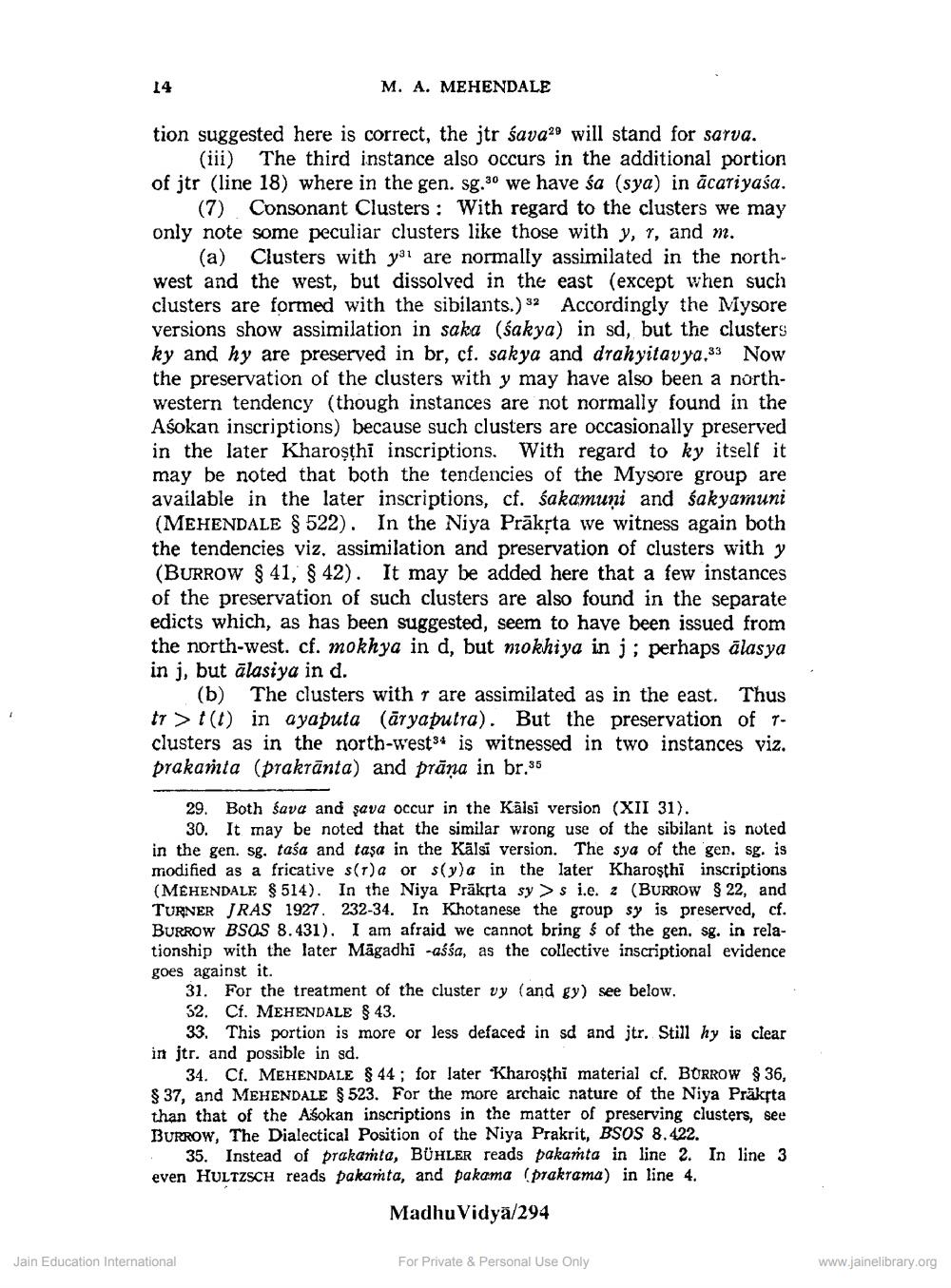________________
14
M. A. MEHENDALE
tion suggested here is correct, the jtr śava29 will stand for sarva.
(iii) The third instance also occurs in the additional portion of jtr (line 18) where in the gen. sg. 30 we have sa (sya) in acariyasa.
(7) Consonant Clusters: With regard to the clusters we may only note some peculiar clusters like those with y, 1, and m.
(a) Clusters with you are normally assimilated in the northwest and the west, but dissolved in the east (except when such clusters are formed with the sibilants.) 32 Accordingly the Mysore versions show assimilation in saka (sakya) in sd, but the clusters ky and hy are preserved in br, cf. sakya and drahyitavya.33 Now the preservation of the clusters with y may have also been a northwestern tendency (though instances are not normally found in the Asokan inscriptions) because such clusters are occasionally preserved in the later Kharoşthi inscriptions. With regard to ky itself it may be noted that both the tendencies of the Mysore group are available in the later inscriptions, cf. sakamuni and sakyamuni (MEHENDALE $ 522). In the Niya Prāksta we witness again both the tendencies viz, assimilation and preservation of clusters with y (BURROW 41, § 42). It may be added here that a few instances of the preservation of such clusters are also found in the separate edicts which, as has been suggested, seem to have been issued from the north-west. cf. mokhya in d, but niokhiya in j; perhaps älasya in j, but alasiya in d.
(b) The clusters with r are assimilated as in the east. Thus t7 > (1) in ayaputa (āryaputra). But the preservation of 7clusters as in the north-wests4 is witnessed in two instances viz. prakamta (prakrānta) and prāna in br.35
29. Both śava and çava occur in the Kälsi version (XII 31).
30. It may be noted that the similar wrong use of the sibilant is noted in the gen. sg. taśa and tasa in the Kālsi version. The sya of the gen. sg. is modified as a fricative s(r)a or s(y)a in the later Kharoşthi inscriptions (MEHENDALE $ 514). In the Niya Prākta sy > s i.e. 2 (BURROW $ 22, and TURNER JRAS 1927. 232-34. In Khotanese the group sy is preserved, cf. BURROW BSOS 8.431). I am afraid we cannot bring $ of the gen. sg. in relationship with the later Māgadhi -aśśa, as the collective inscriptional evidence goes against it.
31. For the treatment of the cluster vy (and gy) see below. 32. Cf. MEHENDALE § 43.
33. This portion is more or less defaced in sd and jtr. Still hy is clear in jtr, and possible in sd.
34. Cf. MEHENDALE $ 44; for later Kharoşthi material cf. BORROW $ 36, $ 37, and MEHENDALE $ 523. For the more archaic nature of the Niya Präkta than that of the Asokan inscriptions in the matter of preserving clusters, see BURROW, The Dialectical Position of the Niya Prakrit, BSOS 8.422. . 35. Instead of prakamta, BÜHLER reads pakaṁta in line 2. In line 3 even HULTZSCH reads pakarta, and pakama (prakrama) in line 4.
Madhu Vidyā/294
Jain Education International
For Private & Personal Use Only
www.jainelibrary.org




